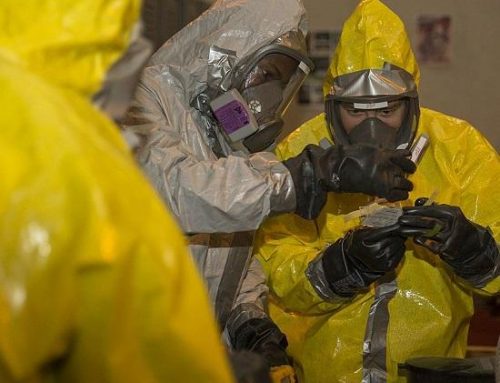A site safety and health plan is an important component of a successful Hazardous Waste Operations and Emergency Response (HAZWOPER) program. A site safety and health plan outline the safety protocols and procedures in place to protect workers and the general public from potential hazards at a worksite. In this article, we’ll provide an overview of site safety and health plans and offer some helpful tips for businesses looking to implement them.
What is a Site Safety and Health Plan?
A site safety and health plan is a written document that outlines the safety protocols and procedures in place to protect workers and the general public from potential hazards at a worksite. A site safety and health plan typically include information about the hazards present at the worksite, the safety protocols and procedures in place to protect workers, and the roles and responsibilities of workers and supervisors.
Why is a Site Safety and Health Plan Important?
A site safety and health plan is important because it helps ensure the safety of workers and the general public by outlining the safety protocols and procedures in place to protect them from potential hazards. By having a clear and comprehensive site safety and health plan, businesses can demonstrate their commitment to safety and help ensure compliance with regulatory requirements.
In addition, a site safety and health plan is an effective tool for promoting a culture of safety within an organization. By regularly reviewing and updating the plan, businesses can help ensure that safety is a top priority for all employees.
Tips for Implementing a Site Safety and Health Plan
Here are 10 tips to help your business implement an effective site safety and health plan:
- Assess the hazards present at the worksite: Carefully assess the hazards present at the worksite to determine what safety protocols and procedures are needed to protect workers and the general public.
- Involve employees in the process: Involving employees in developing the site safety and health plan can help ensure their buy-in and support for the program.
- Clearly outline the roles and responsibilities of workers and supervisors: Make sure the roles and responsibilities are clearly outlined in the site safety and health plan.
- Regularly review and update the plan: Regularly review and update the site safety and health plan to ensure it is still effective and in compliance with any changes in laws or regulations.
- Ensure that all employees are trained on the plan: All employees, including new hires and temporary workers, are trained on the site safety and health plan.
- Make the plan easily accessible: Ensure that the site safety and health plan is easily accessible to all employees.
- Follow established protocols: Follow established protocols for implementing the site safety and health plan to ensure consistent and reliable training.
- Keep thorough records: Maintain thorough records of all site safety and health plan activities.
- Include supervisors and managers in the plan: It’s important to involve supervisors and managers in the site safety and health plan to ensure that they know the hazards and risks at the worksite and how to protect their employees.
- Supplement the plan with ongoing training: The site safety and health plan should be the starting point for ongoing safety training. Consider implementing regular safety training sessions or refresher courses to keep employees informed and up-to-date on safety protocols and procedures.
Conclusion
A site safety and health plan is an important component of a successful HAZWOPER program. By implementing an effective site safety and health plan and regularly reviewing and updating your program, you can help protect the health and well-being of your employees and the community. It’s worth noting that a site safety and health plan is just one part of a successful HAZWOPER program. Other key elements include personal protective equipment, monitoring procedures and equipment, and emergency response planning. To ensure the safety of your workers and compliance with regulatory requirements, it’s important to have a well-rounded program that addresses all of these areas.
It’s also important to note that a site safety and health plan should be customized to the specific needs of your business and the hazards present at your worksite. It’s crucial to conduct a thorough hazard assessment and consult with experts to ensure that your plan is comprehensive and effective. By taking the time to carefully develop and implement a site safety and health plan, you can help ensure the safety and well-being of your workers and the community.
Do you need HAZWOPER Online Training?
Try a free demonstration of HAZWOPER: Site Safety and Health Plan
Excerpt from the outline for HAZWOPER: Site Safety and Health Plan
OUTLINE OF MAJOR PROGRAM POINTS
The following outline summarizes the major points of information presented in the program. The outline can be used to review the program before conducting a classroom session, as well as in preparing to lead a class discussion about the program.
Whether you’re at home or at work, safety is always a major concern, especially when you’re dealing with hazardous chemicals. You need to:
— Know what you can do to work with chemicals as safely as possible.
— Be prepared in case something goes wrong.
That’s why your facility has a site safety and health plan.
— It is a written plan of action for people who work around hazardous chemicals.
— The plan sets out guidelines for working with chemicals safely and provides procedures for dealing with accidents.
Most of us have worked with some type of potentially hazardous chemical at one time or another… even if it’s only been at home.
— At home you have to rely on the chemical’s label to tell you what to do if a leak or spill occurs.
— In the workplace, you need more detailed information.
Following the guidelines in the site safety and health plan will help you identify, evaluate and control safety and health hazards before they become a problem, so that you can stay safe.
The goals of a site safety and health plan are to:
— Reduce workers’ risk of chemical exposure.
— Guard the public from the site’s hazards.
— Protect the environment from contamination.
To accomplish these goals, a site safety and health plan includes information on:
— Employee orientation.
— Training.
— Health and safety rules.
— Correct work procedures.
— Workplace inspections.
Because quick action is often needed during a hazardous release, the plan also discusses:
— How to contact your site’s emergency response team.
— What the team will do if an accident occurs.
Some of the most important information in the plan deals with “job safety”. As part of this focus, the plan contains:
— A list of safety and health hazards for each job that is performed at your site.
— The steps to take to minimize these hazards.
— Emphasis is placed on the importance of employees taking “individual responsibility” for the safety of the work they are involved in.
But the mere existence of a site safety and health plan isn’t enough. To operate safely, your company needs you and your coworkers to:
— Be alert.
— Follow the safety rules that the plan lays out.
To make sure that everyone starts off on the right track:
— Your company holds special orientations for workers who have just been hired so that they can become familiar with your worksite.
— In addition, each worker receives training that examines the hazards associated with their specific job.
It is important that you pay close attention to all of the training that your facility provides.
— Since it includes a review of your company’s health and safety rules, it is key to keeping everyone safe.
— But you aren’t the only one who has responsibilities… your company has duties of its own.
One of these involves “medical surveillance”.
— This begins with “screening” you for any existing medical problems before allowing you to work with hazardous materials.
As part of this medical surveillance, you will:
— Go through periodic evaluations to track any changes to your health as well.
— Be given additional special exams if you are exposed to a hazardous chemical.
— Be given a medical examination if you are re-assigned to another site or when you leave your job.
If you have developed a medical problem that you didn’t have prior to working with the materials at your site, the results of these exams will help the doctor to determine:
— What caused the illness.
— What type of treatment you need to receive.
In addition to monitoring your health, your company is also responsible for making sure that the equipment used on your site is in good condition and functioning safely.
— Equipment will be inspected periodically to make sure that it is running properly.
— Records will be kept of past breakdowns and mechanical problems so that preventative maintenance programs can be developed to keep new problems from occurring.
Your company will also establish “correct work procedures” for the various jobs on your site, which will be included in your site safety and health plan.
— These procedures outline the safest way to do a job, and provide guidelines for job training, performance evaluation and accident investigation.
— By learning the safest way to perform a job, you can help to prevent things like chemical spills and other accidents.










